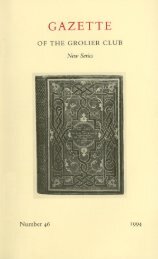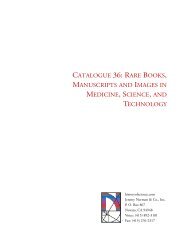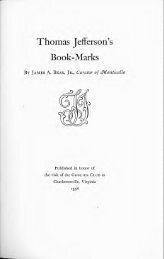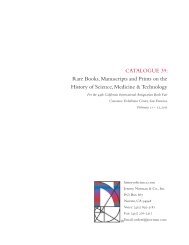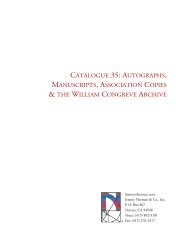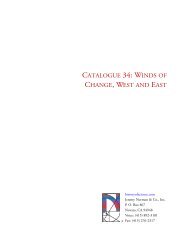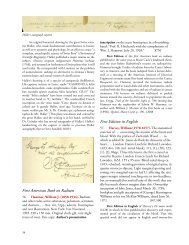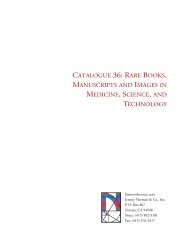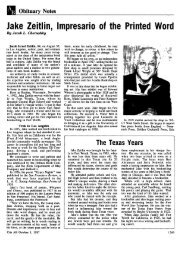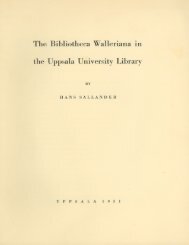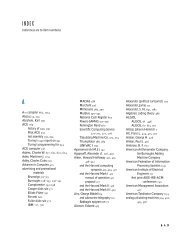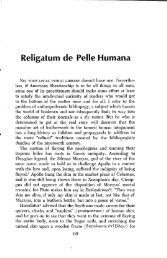Catalogue 38, Part 3 - Jeremy Norman's HistoryofScience.com
Catalogue 38, Part 3 - Jeremy Norman's HistoryofScience.com
Catalogue 38, Part 3 - Jeremy Norman's HistoryofScience.com
Create successful ePaper yourself
Turn your PDF publications into a flip-book with our unique Google optimized e-Paper software.
Owen’s Principal Forms of the Skeleton was a popular<br />
rendition of his On the Archetype and Homologies of the<br />
Vertebrate Skeleton (1849), the work in which he laid<br />
out his system of <strong>com</strong>parative osteology and developed<br />
his concept of the vertebrate archetype. “The vertebrate<br />
archetype (from the Greek arkhe, ‘original,’ and tupos,<br />
‘imprinted image’) is one of the most fascinating constructs<br />
of what has been called the ‘morphological<br />
period’ in the history of biology (approximately 1800-<br />
1860). It represented the fullest expression of a belief in<br />
the fundamental relatedness, if not of all organisms, at<br />
least of all animals with endoskeletons. Moreover, as<br />
Darwin scholars have long recognized, the vertebrate<br />
archetype provided a direct stepping-stone to the<br />
notion of evolutionary ancestors” (Rupke, “Richard<br />
Owen’s vertebrate archetype,” 231). The Principal<br />
Forms of the Skeleton was issued in both parts and in<br />
book form, and went through at least a dozen English<br />
and American editions. Rupke, “Richard Owen’s vertebrate<br />
archetype,” Isis 84 (1993): 231-251; Richard<br />
Owen, Victorian Naturalist (1994), pp. 161-170.<br />
40856<br />
“Your Wicked Daughter has Notions in<br />
her Pate about Nursing”<br />
84. Osler, William (1849-1919). Autograph<br />
letter signed to Mrs. [John A.] Mullin, with<br />
stamped cover. [Baltimore], October 14, 1900. 1<br />
page, on Osler’s 1 West Franklin St. stationery.<br />
160 x 115 mm. Light soiling, a few spots on cover,<br />
but very good. Docketed by recipient. $3750<br />
A charming and humorous letter from Osler to<br />
the widow of his old friend Dr. John A. Mullin (1835-<br />
99) of Hamilton, Ontario. Osler had be<strong>com</strong>e<br />
acquainted with the Mullins in the 1870s, around the<br />
time he began teaching at McGill University. Osler<br />
credited Dr. Mullin with being the first to observe<br />
“Osler’s nodes,” the cutaneous nodes in subacute bacterial<br />
endocarditis; Mullin had apparently demonstrated<br />
the nodes to Osler at the Hamilton City<br />
Hospital (Buchanan, pp. 163-64). Osler’s affectionate<br />
relationship with Mrs. Mullin is apparent in the present<br />
letter:<br />
Dear Mrs. Mullin, Mrs. Osler tells me that your<br />
wicked daughter has notions in her pate about<br />
nursing. Do you encourage them? If so I would<br />
also as I am sure she would make a first class nurse<br />
& be most helpful & useful. She is certainly<br />
strong enough. I hope you are keeping well. Love<br />
to all the boys. You sincere friend, Wm. Osler.<br />
Osler’s letter is also of interest in that it demonstrates<br />
his approval of nursing as a career for women, an opinion<br />
that he expressed more fully in his Medicine and<br />
Nursing (1919). Buchanan, “Sir William Osler (1849-<br />
1919): The Early Years,” Proceedings of the Royal College<br />
of Physicians of Edinburgh 31 (2001): 155-168. Cushing,<br />
Life of Sir William Osler, pp. 121, 487. 40797<br />
Pasteur Autograph and Portrait<br />
85. Pasteur, Louis (1822-95). Signed autograph<br />
inscription in French (4 lines plus signature).<br />
N.p., n.d. Approx. 173 x 118 mm.<br />
Translation included. W ith:Lawford,T.Hamilton.Hand-colored<br />
mezzotint portrait of Pasteur,<br />
signed by the engraver in pencil, after the painting<br />
76



